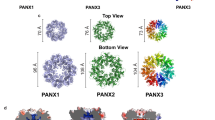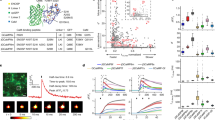Abstract
Connexins are membrane proteins that assemble into gap-junction channels and are responsible for direct, electrical and metabolic coupling between connected cells. Here we describe an investigation of the properties of a recombinantly expressed recessive mutant of connexin 26 (Cx26), the V84L mutant, associated with deafness. Unlike other Cx26 mutations, V84L affects neither intracellular sorting nor electrical coupling, but specifically reduces permeability to the Ca2+-mobilizing messenger inositol 1,4,5-trisphosphate (Ins(1,4,5)P3). Both the permeability to Lucifer Yellow and the unitary channel conductance of V84L-mutant channels are indistinguishable from those of the wild-type Cx26. Injection of Ins(1,4,5)P3 into supporting cells of the rat organ of Corti, which abundantly express Cx26, ensues in a regenerative wave of Ca2+ throughout the tissue. Blocking the gap junction communication abolishes wave propagation. We propose that the V84L mutation reduces metabolic coupling mediated by Ins(1,4,5)P3 to an extent sufficient to impair the propagation of Ca2+ waves and the formation of a functional syncytium. Our data provide the first demonstration of a specific defect of metabolic coupling and offer a mechanistic explanation for the pathogenesis of an inherited human disease.
This is a preview of subscription content, access via your institution
Access options
Subscribe to this journal
Receive 12 print issues and online access
$209.00 per year
only $17.42 per issue
Buy this article
- Purchase on Springer Link
- Instant access to full article PDF
Prices may be subject to local taxes which are calculated during checkout




Similar content being viewed by others
References
Harris, A. L. Emerging issues of connexin channels: biophysics fills the gap. Q. Rev. Biophys. 34, 325–472 (2001).
Gerido, D. A. & White, T. W. Connexin disorders of the ear, skin, and lens. Biochim. Biophys. Acta 1662, 159–70 (2004).
Jentsch, T. J. Neuronal KCNQ potassium channels: physiology and role in disease. Nature Rev. Neurosci. 1, 21–30 (2000).
Bruzzone, R. et al. Loss-of-function and residual channel activity of connexin26 mutations associated with non-syndromic deafness. FEBS Lett. 533, 79–88 (2003).
D'Andrea, P. et al. Hearing loss: frequency and functional studies of the most common connexin26 alleles. Biochem. Biophys. Res. Commun. 296, 685–691 (2002).
Skerrett, I. M., Di, W. L., Kasperek, E. M., Kelsell, D. P. & Nicholson, B. J. Aberrant gating, but a normal expression pattern, underlies the recessive phenotype of the deafness mutant Connexin26M34T. FASEB J. 18, 860–862 (2004).
Kenna, M. A., Wu, B. L., Cotanche, D. A., Korf, B. R. & Rehm, H. L. Connexin 26 studies in patients with sensorineural hearing loss. Arch. Otolaryngol. Head Neck Surg. 127, 1037–1042 (2001).
Kelley, P. M. et al. Novel mutations in the connexin 26 gene (GJB2) that cause autosomal recessive (DFNB1) hearing loss. Am. J. Hum. Genet. 62, 792–799 (1998).
Wang, H. L. et al. Functional analysis of connexin-26 mutants associated with hereditary recessive deafness. J. Neurochem. 84, 735–742 (2003).
Elfgang, C. et al. Specific permeability and selective formation of gap junction channels in connexin-transfected HeLa cells. J. Cell Biol. 129, 805–817 (1995).
Beltramello, M. et al. Permeability and gating properties of human connexins 26 and 30 expressed in HeLa cells. Biochem. Biophys. Res. Commun. 305, 1024–1033 (2003).
Verselis, V. K. & Veenstra, R. in Gap Junctions, Vol. 30 (ed. Hertzberg, E. L.) 129–193 (JAI, Stamford, CT, 2000).
Peracchia, C. Chemical gating of gap junction channels; roles of calcium, pH and calmodulin. Biochim. Biophys. Acta. 1662, 61–80 (2004).
Bukauskas, F. F. & Verselis, V. K. Gap junction channel gating. Biochim. Biophys. Acta. 1662, 42–60 (2004).
Thomas, D. et al. Microscopic properties of elementary Ca2+ release sites in non-excitable cells. Curr. Biol. 10, 8–15 (2000).
Saez, J. C., Connor, J. A., Spray, D. C. & Bennett, M. V. Hepatocyte gap junctions are permeable to the second messenger, inositol 1,4,5-trisphosphate, and to calcium ions. Proc. Natl Acad. Sci. USA 86, 2708–2712 (1989).
Kam, Y., Kim, D. Y., Koo, S. K. & Joe, C. O. Transfer of second messengers through gap junction connexin 43 channels reconstituted in liposomes. Biochim. Biophys. Acta. 1372, 384–388 (1998).
Niessen, H., Harz, H., Bedner, P., Kramer, K. & Willecke, K. Selective permeability of different connexin channels to the second messenger inositol 1,4,5-trisphosphate. J. Cell. Sci. 113, 1365–1372 (2000).
Niessen, H. & Willecke, K. Strongly decreased gap junctional permeability to inositol 1,4,5-trisphosphate in connexin32 deficient hepatocytes. FEBS Lett. 466, 112–114 (2000).
Abbracchio, M. P. & Burnstock, G. Purinoceptors: are there families of P2X and P2Y purinoceptors? Pharmacol. Ther. 64, 445–475 (1994).
Bennett, M. V., Contreras, J. E., Bukauskas, F. F. & Saez, J. C. New roles for astrocytes: gap junction hemichannels have something to communicate. Trends Neurosci. 26, 610–617 (2003).
Goodenough, D. A. & Paul, D. L. Beyond the gap: functions of unpaired connexon channels. Nature Rev. Mol. Cell Biol. 4, 285–294 (2003).
Lautermann, J. et al. Expression of the gap-junction connexins 26 and 30 in the rat cochlea. Cell Tissue Res. 294, 415–420 (1998).
Gale, J. E., Piazza, V., Ciubotaru, C. D. & Mammano, F. A mechanism for sensing noise damage in the inner ear. Curr. Biol. 14, 526–529 (2004).
Oh, S. et al. Changes in permeability caused by connexin 32 mutations underlie X-linked Charcot-Marie-Tooth disease. Neuron 19, 927–938 (1997).
Lagostena, L., Cicuttin, A., Inda, J., Kachar, B. & Mammano, F. Frequency dependence of electrical coupling in Deiters' cells of the guinea pig cochlea. Cell Commun. Adhes. 8, 393–399 (2001).
Lagostena, L., Ashmore, J. F., Kachar, B. & Mammano, F. Purinergic control of intercellular communication between Hensen's cells of the guinea-pig cochlea. J. Physiol. 531, 693–706 (2001).
Boettger, T. et al. Deafness and renal tubular acidosis in mice lacking the K-Cl co-transporter Kcc4. Nature 416, 874–878 (2002).
Cohen-Salmon, M. et al. Targeted ablation of connexin26 in the inner ear epithelial gap junction network causes hearing impairment and cell death. Curr. Biol. 12, 1106–1111 (2002).
Forge, A., Marziano, N. K., Casalotti, S. O., Becker, D. L. & Jagger, D. The inner ear contains heteromeric channels composed of cx26 and cx30 and deafness-related mutations in cx26 have a dominant negative effect on cx30. Cell. Commun. Adhes. 10, 341–346 (2003).
Acknowledgements
This work was supported by grants from the Telethon Foundation, (Project n. GGP02043), the Ministero dell' Università e Ricerca Scientifica (MIUR, FIRB n. RBAU01Z2Z8, PRIN-COFIN 2002067312_002) to F.M., the Centro di Eccellenza (co-ordinator, T.P.) and the Italian Health Ministry. We thank R. Bruzzone (Institute Pasteur, Paris, France) for helpful comments, S. Bastianello, M. Bortolozzi and C. D. Ciubotaru (Venetian Institute of Molecular Medicine, Padua, Italy) for help with computer programming and image processing.
Author information
Authors and Affiliations
Corresponding author
Ethics declarations
Competing interests
The authors declare no competing financial interests.
Supplementary information
Supplementary Information
Fig S1, Fig S2 (PDF 364 kb)
Supplementary Information
Movie 1 (AVI 1304 kb)
Rights and permissions
About this article
Cite this article
Beltramello, M., Piazza, V., Bukauskas, F. et al. Impaired permeability to Ins(1,4,5)P3 in a mutant connexin underlies recessive hereditary deafness. Nat Cell Biol 7, 63–69 (2005). https://doi.org/10.1038/ncb1205
Received:
Accepted:
Published:
Issue Date:
DOI: https://doi.org/10.1038/ncb1205
This article is cited by
-
TRPA1 activation in non-sensory supporting cells contributes to regulation of cochlear sensitivity after acoustic trauma
Nature Communications (2023)
-
MITF variants cause nonsyndromic sensorineural hearing loss with autosomal recessive inheritance
Scientific Reports (2020)
-
Connexin43 and connexin50 channels exhibit different permeability to the second messenger inositol triphosphate
Scientific Reports (2020)
-
Connexinopathies: a structural and functional glimpse
BMC Cell Biology (2016)
-
ATP-Evoked Intracellular Ca2+ Signaling of Different Supporting Cells in the Hearing Mouse Hemicochlea
Neurochemical Research (2016)



